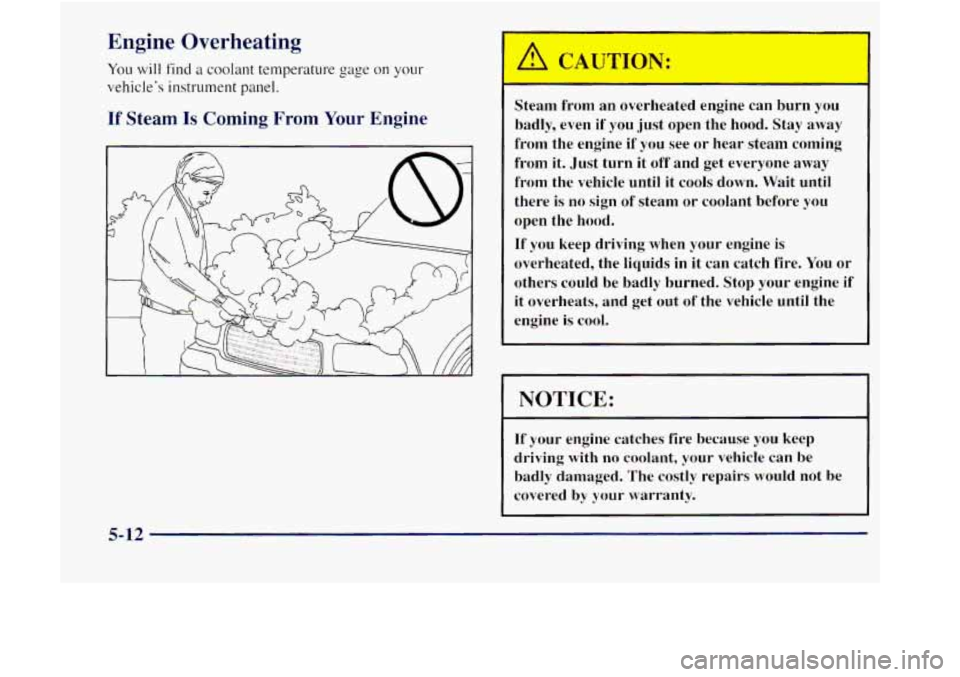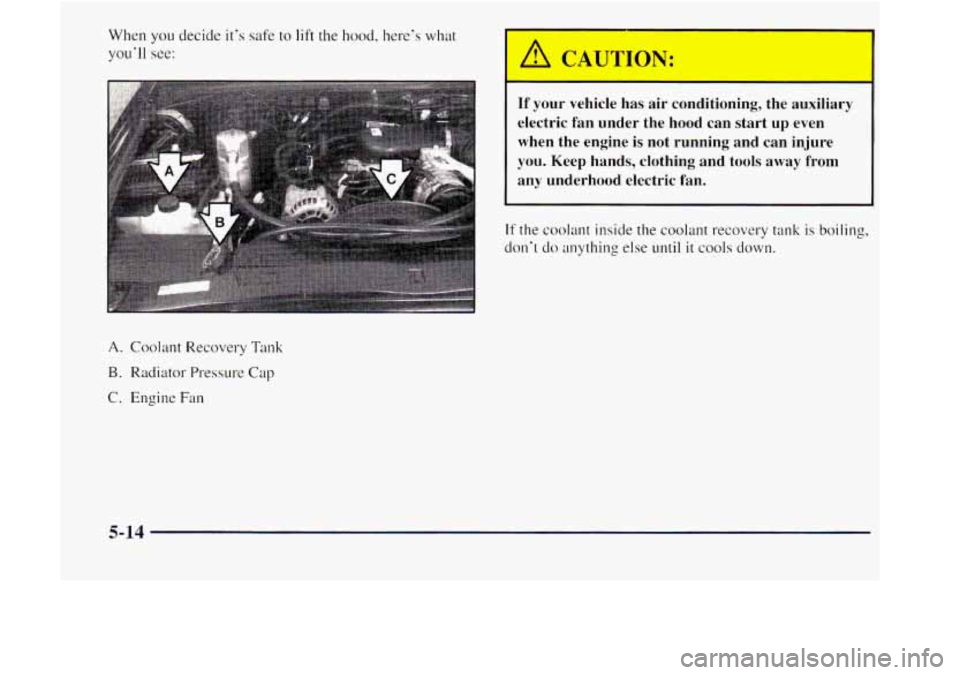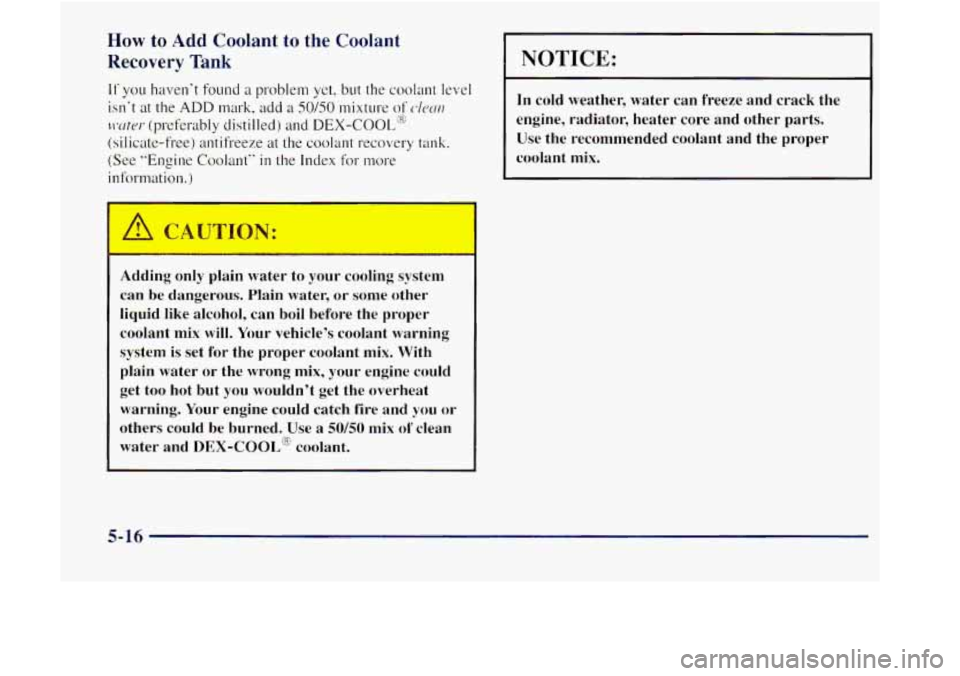engine GMC JIMMY 1997 Workshop Manual
[x] Cancel search | Manufacturer: GMC, Model Year: 1997, Model line: JIMMY, Model: GMC JIMMY 1997Pages: 410, PDF Size: 20.03 MB
Page 227 of 410

7. Don't let the other end
touch metal. Contwct it to
the positive (+) terminal
8. Now connect the
black negative (-) cable
to the good battery's
negative
(-) terminal.
Don't let the other
end
touch anything until the
next step. The other end
of the negative cable
doesn't go to the dead
battery.
It pes to a heavy
unpainted metal ~U'I on
the engine of the vehicle
with the dead battery.
9. Attach the cable at least
18 inches (45 crn) away
from
the dead battery,
but
not near engine purts
that ITIOW.
The electrical
connection
is just as
good there, but the
chance
of sparks getting
back to
the battery is
much less.
10. Now start the vehicle with the good battery and run
the engine for ;1 while.
1 I. Try to start the vehicle with the dead battery. If it
won't start after a few tries make sure all
connections we good. If it still won't start. it
probably needs service.
A CAUTION:
I
Fans or other moving engine parts can injure you
badly. Keep your hands away from moving parts
once the engines arc running.
5-6
Page 233 of 410

Engine Overheating
You will find a coolant temperature gage on your
vehicle's instrument panel.
If Steam Is C . - g I; - ___I Your Engine
Steam from an overheated engine can burn you
badly, even if you just open the hood. Stay away
from the engine
if you see or hear steam coming
from it. Just turn it off and get everyone
away
from the vehicle until it cools down. Wait until
there
is no sign of steam or coolant before you
open the hood.
If you keep driving when your engine is
overheated, the liquids in it can catch fire,
You or
others could be badly burned.
Stop your engine if
it overheats, and get out of the vehicle until the
engine
is cool.
NOTICE:
If your engine catches fire because you keep
driving with no coolant, your vehicle can
be
badly damaged. The costly repairs would not be
covered by your warranty.
5-12
Page 234 of 410

If No Steam Is Coming From Your Engine
If you zet the overheat warning but see or hear no
steam. the problem may not be too serious. Sometimes
the engine can get
a little too hot when you:
0 Climb a long hill on a hot day.
Stop after high-speed driving.
Idle for long periods in traffic.
Tow a trailer. See "Driving on Grades" in the Index.
If you get the overheat warning with no sign of steam,
try this for a minute
or so:
2. T~11-11 on yo~~r heater to full hot at the highest fan
speed and open the window as necessary.
3. If you're in a traffic jam. shift to NEUTRAL (N):
otherwise, shift to the highest gear \vhile
driving -- AUTOMATIC OVERDRIVE ((33) or
DRIVE (D) for automatic transmissions.
If you no longer have the overheat warning. you
can drive. Just
to be safe. drive slower for about
10 minutes. If the warning doesn't come back on.
you can drive norrnally.
If the warning continues. pull over, stop, and park your
vehicle right away.
If there's still no sign of steam. push the accelerator until
the engine speed is about twice as fast as normal idle
speed. Bring the engine speed back
to normal idle speed
after two or three minutes. Now see
if the warning stops.
But then, if you still have the warning, rum ogtlw
eugine
c~l got el?er;\.olw out oftlw \vl~iclc. until it
cools down.
You
may decide not to lift the hood but to get service
help right
away.
5-13
Page 235 of 410

When you decide it's safe to lift the hood. here's what
you'll see:
A. Coolant Recovery Tank
B. Radiator Pressure Cap
C. Engine Fan
A CAUTION:
r
If your vehicle has air conditioning, the auxiliary
electric fan under the hood can start
up even
when the engine is not running and can injure
you. Keep hands, clothing and tools away
from
any underhood electric fan.
If the coolant inside the coolant recovery tank is boiling,
don't
do anything else until it cools down.
5-14
Page 236 of 410

Heater and radiator hoses, and other engine
parts, can be very hot. Don't touch them.
If' you
do, you can be burned.
Don't run the engine
if there is a leak. If' you run
the engine, it could lose all coolant. That
could
cause an engine fire, and you could be burned.
Get any leak fixed before
you drive the vehicle.
I NOTICE:
Engine damage from running your engine
without coolant isn't
covered by your warranty.
If there seems to be 110 leak, start the engine again. See
if the t'an speed increases when idle speed is doubled by
pushing the accelerator pedal
down. If it doesn't. your
vehicle needs service. T~1l-11
off the engine.
Page 237 of 410

How to Add Coolant to the Coolant
Recovery Tank
If you haven't found a problem yet, but the coolant level
isn't at the
ADD mark, add a SO/SO mixture of d~ctrz
,twtur (preferably distilled) and DEX-COOL'@
(silicate-free) antifreeze at the coolant recovery tank.
(See "Engine Coolant" in the Index for more
information.
)
_s I
Adding only plain water to your cooling system
can be dangerous. Plain water, or some other
liquid like alcohol, can boil before the proper
coolant mix
will. Your vehicle's coolant warning
system is set for the proper coolant mix. With
plain water or the wrong mix, your engine could
get too hot but you wouldn't get the overheat
warning. Your engine could catch fire and you or
others could be burned. Use
a 50/50 mix of clean
water and
DEX-COOL" coolant.
NOTICE:
In cold weather, water can freeze and crack the
engine, radiator, heater core and other parts. Use the recommended coolant and the proper
coolant mix.
5-16
Page 238 of 410

You can be burned if you spill coolant on hot
engine parts. Coolant contains ethylene glycol
and
it will burn if the engine parts are hot
enough. Don’t spill coolant on
a hot engine.
5-17
Page 243 of 410

Engine Fan Noise If a Tire Goes Flat
This vehicle has a clutched engine cooling fan. When
the clutch is engaged,
the fan spins faster to provide
more air to cool the engine.
In most everyday driving
conditions, the clutch
is not engaged. This improves
fuel economy and reduces
fan noise. Under heavy
vehicle loading, trailer towing and/or high outside
temperatures, the
fan speed increases when the clutch
engages.
So you may hear an increase in fan noise. This
is normal and should not be mistaken as the
transmission slipping
or making extra shifts. It is merely
the cooling system functioning properly. The fan will
slow down when additional cooling is not required and
the clutch disengages.
You
may also hear this fan noise when you start he
engine.
It will go away as the fan clutch disengages. It's
unusual
for a tire to "blow out" while you're driving,
especially
if you maintain your tires properly. If air goes
out of
a tire, it's muc11 more likely to leak out slowly.
But if you should ever have a "blowout." here are a few
tips about what
to expect and what to do:
If a front tire fails, the flat tire will create a drag that
pulls the vehicle toward that side. Take your foot off the
accelerator pedal and grip the steering wheel firmly.
Steer to ~naintain lane position, and then gently brake to
a stop well out of the traffic lane.
A rear blowout. particularly on a curve, acts much like a
skid and may require the same correction you'd use in a
skid. In any rear blowout, remove yo~~r foot from the
accelerator pedal. Get the c.ehicle under control
by
steering the way ~OLI want the vehicle to go. It may be
very bumpy
and noisy. but you can still steer. Gently
brake to
a stop -- well off the road if possible.
5-22
Page 244 of 410

Changing a Flat Tire
If a tire goes flat, avoid further tire and wheel damage
by driving slowly to a level place. Turn on your hazard
warning flashers.
A CAUTION:
Changing a tire can cause an injury. The vehicle
can slip off the jack and roll over you or other
people. You and they could be badly injured.
Find a level place to change your tire.
To help
prevent the vehicle from moving:
1. Set the parking brake firmly.
2. Put an automatic transmission shift
lever in PARK
(P) or shift a manual
transmission to FIRST
(1) or
REVERSE (R).
CAUTIQN: iContinued) .~
3. If you have a four-wheel-drive vehicle
with a manual transfer case shift lever,
be sure the transfer case is in a drive
gear
-- not in NEUTRAL (N).
4. Turn off the engine.
5. Put the wheel blocks at the front and
rear
of the tire farthest away from the
one being changed. That would be the
tire on the other side of the vehicle,
at
the opposite end.
5-23
Page 257 of 410

~ ~~ ~~
~~~ ~~~ NOTICE:
When
the compact spare is installed, don’t take
your vehicle through an automatic car wash with
guide rails. The compact spare can get caught on
the rails. That can damage the tire and wheel,
and maybe other parts
of your vehicle.
Don’t use your compact spare on other vehicles.
And
don’t mix your compact spare tire or wheel with
other wheels or tires. They won’t fit. Keep your spare
tire and its wheel together.
NOTICE:
Tire chains won’t fit your compact spare. Using
them can damage your vehicle and can damage
the chains too. Don’t use tire chains on your
compact spare.
If You’re Stuck: In Sand, Mud,
Ice or Snow
What you don’t want to do when your vehicle is stuck is
to spin your wheels too fast. The method known as
“rocking” can help you get out when you’re stuck, but
you must use caution.
If you let your tires spin at high speed, they can
explode, and you or others could be injured. And,
the transmission or other parts
of the vehicle can
overheat. That could cause an engine
compartment fire or other damage. When you’re
stuck, spin the wheels
as little as possible. Don’t
spin the wheels above 35 mph
(55 kmh) as shown
on the speedometer.
5-36 j